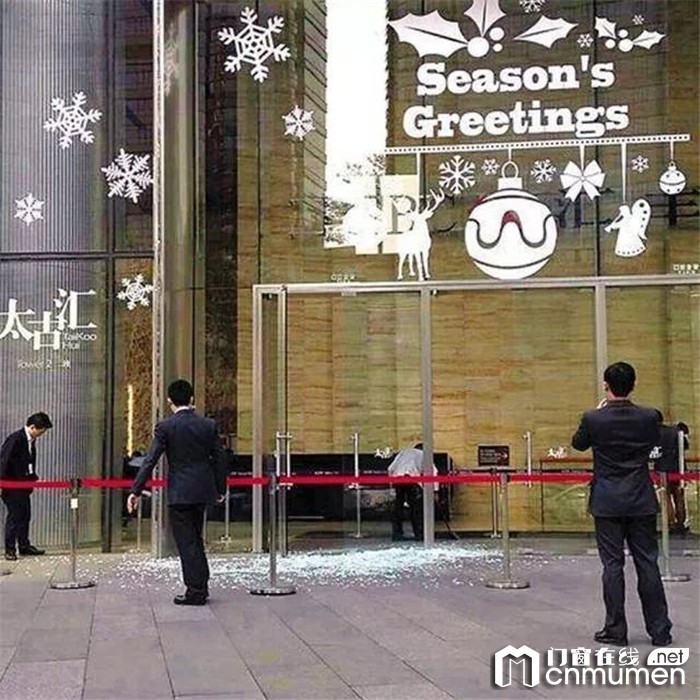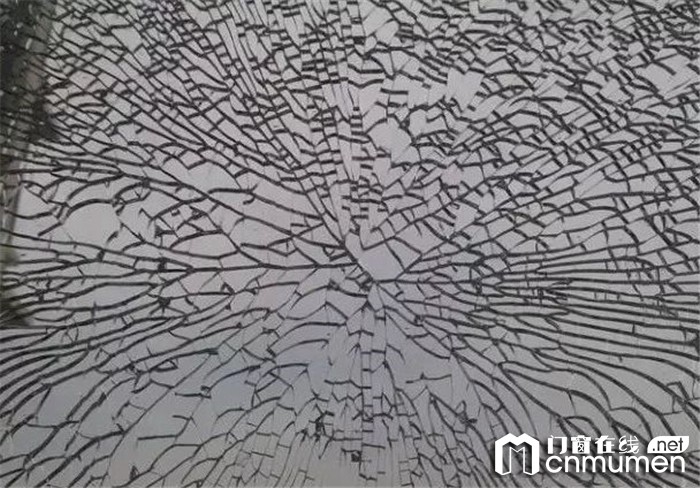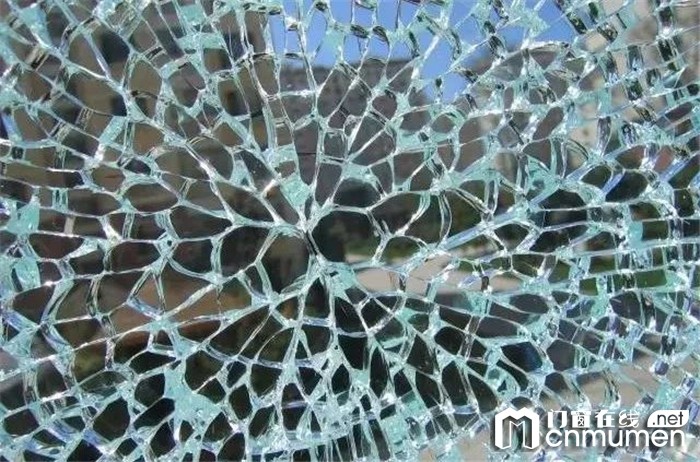Every summer, many regions across the country have entered the "barbecue mode". Many cities often report the explosion of high-rise construction glass curtain wall tempered glass. So is it really like the glass mentioned in the news was exploded by high temperature barbecue? Let's take you through the reasons for toughened glass self-explosion.
In fact, since the birth of tempered glass, it has been accompanied by the problem of self-explosion. Toughened glass self-explosion can be expressed as the phenomenon that tempered glass automatically breaks without external direct action. Toughened glass self-explosion can occur during tempering processing, storage, transportation, installation, use, etc.

Self-explosion rate of tempered glass
The domestic self-explosion rate varies from 3% to 0.3% by manufacturers. Generally, the self-explosion rate is calculated according to the number of pieces. The area size and glass thickness of single piece of glass are not considered, so it is not accurate enough and it is impossible to make a more scientific comparison with each other. In order to calculate the self-explosion rate uniformly, a unified hypothesis must be determined. Set a unified condition: every 5 to 8 tons of glass contains a nickel sulfide enough to trigger self-explosion; The area of each tempered glass is 1.8?; Nickel sulfide is evenly distributed. Then the calculated self-explosion rate of 6mm thick tempered glass is 0.64%~ 0.54%, that is, the self-explosion rate of 6mm tempered glass is about 3‰ ~ 5 ‰. This is basically consistent with the actual value of domestic high-level processing enterprises.
Even if it is completely produced according to the standard, toughened glass self-explosion cannot be completely avoided. Large buildings easily use hundreds of tons of glass, which means that nickel sulfide and heterogeneous impurities in the glass are likely to exist, so although tempered glass is hot dipped, self-explosion is still inevitable.
Toughened glass self-explosion mechanism
Self-explosion can be divided into two types according to different causes:
The first is self-explosion caused by visible defects in glass, such as stones, sand particles, bubbles, inclusion, notch, scratch, bursting edge, etc.; The second is nickel sulfide (NIS) in glass. Impurities and heterogeneous particles cause toughened glass self-explosion. The diameter of nickel sulfide causing self-explosion is between 0.04 and 0.65mm, and the average particle size is 0.2mm. Now there are also newly discovered toughened glass self-explosion caused by heterogeneous particles.

These are two different types of self-explosion, which should be clearly classified, treated differently, and treated with different methods. The former is generally visible visually and relatively easy to detect, so it is controllable in production. The latter is mainly caused by the small volume expansion of nickel sulfide particles in the glass, which cannot be inspected visually, so it is uncontrollable. In terms of actual operation and treatment, the former can generally be removed before installation, while the latter continues to exist because it cannot be tested, which becomes the main factor of toughened glass self-explosion in use. The replacement of nickel sulfide after self-explosion is difficult and the handling cost is high. At the same time, it will be accompanied by relatively large quality complaints and economic losses, resulting in the dissatisfaction of owners and even more serious other consequences.
Toughened glass self-explosion there are some other factors: unreasonable glass slotting and drilling, poor quality of raw glass, uneven thickness, such as pattern glass, uneven stress distribution, such as curved tempered glass and regional tempered glass.

How to identify self-explosion of tempered glass
First, look at whether the burst point (the crack of tempered glass is radial, and both have starting points) is in the middle of the glass. For example, at the edge of the glass, it is usually because the glass has not been chamfered or the glass edge has been damaged, caused by stress concentration and crack development gradually; If the explosion point is in the middle of the glass, see if there is a pattern similar to two butterfly wings composed of two small polygon (butterfly plaque), if you carefully observe that the common edge of two small polygon (the trunk part of butterfly) should have small black particles (nickel sulfide stones) visible to the naked eye, you can judge that it is self-explosive; otherwise, it should be destroyed by external forces. The typical feature of glass self-explosion is Butterfly plaque. The glass fragments are radially distributed, and there are two glass blocks shaped like butterfly wings in the Radiation Center, commonly known as "butterfly plaque". Nickel sulfide stones are located at the interface of two "butterfly plaque.
So how should such a self-explosion be defended?
1. Use laminated glass:
Clamp PVB interlayer film between the glass and make it through high temperature and high pressure processing. The toughness of PVB film is very good. Laminated glass can absorb a large amount of impact energy and rapidly decay it when it is cracked by external force, so it is difficult to breakdown laminated glass and maintain excellent integrity. This enables buildings with laminated glass to remain in the frame of doors and windows even if the glass is broken when they are exposed to explosion, wind disaster, earthquake, etc, protect people inside and outside the building from the hazards of splash glass fragments, and it is difficult for wind and rain and other foreign objects to cause damage to the interior. The disadvantages are:
1) the weight and thickness of the glass increase the load bearing and load of the building;
2) fire is not conducive to escape and rescue;
2. Give Glass Paster films:
Stick high-performance polyester film on the glass. Polyester Film is commonly known as safety explosion-proof. When glass is broken for various reasons, it can stick to glass fragments to prevent splashing and protect people inside and outside the building from the harm of splashing glass fragments, wind and rain and other foreign objects are also difficult to cause damage to the interior. Safety explosion-proof can be connected with the frame edge system together with organic glue to form a glass film protection system to prevent falling.
3. Installation enclosure design:
Guard bars are set at crowded places to prevent losses caused by glass fragmentation.
4. Select super white stalinite:
Good thermal stability, high strength, low self-explosion rate (approaching 0), safe use, high light transmittance, good permeability, high-end, high technical content and wide application range.

Edit: doors and windows online-berries


 Self-explosion rate of tempered glass
The domestic self-explosion rate varies from 3% to 0.3% by manufacturers. Generally, the self-explosion rate is calculated according to the number of pieces. The area size and glass thickness of single piece of glass are not considered, so it is not accurate enough and it is impossible to make a more scientific comparison with each other. In order to calculate the self-explosion rate uniformly, a unified hypothesis must be determined. Set a unified condition: every 5 to 8 tons of glass contains a nickel sulfide enough to trigger self-explosion; The area of each tempered glass is 1.8?; Nickel sulfide is evenly distributed. Then the calculated self-explosion rate of 6mm thick tempered glass is 0.64%~ 0.54%, that is, the self-explosion rate of 6mm tempered glass is about 3‰ ~ 5 ‰. This is basically consistent with the actual value of domestic high-level processing enterprises.
Even if it is completely produced according to the standard, toughened glass self-explosion cannot be completely avoided. Large buildings easily use hundreds of tons of glass, which means that nickel sulfide and heterogeneous impurities in the glass are likely to exist, so although tempered glass is hot dipped, self-explosion is still inevitable.
Toughened glass self-explosion mechanism
Self-explosion can be divided into two types according to different causes:
The first is self-explosion caused by visible defects in glass, such as stones, sand particles, bubbles, inclusion, notch, scratch, bursting edge, etc.; The second is nickel sulfide (NIS) in glass. Impurities and heterogeneous particles cause toughened glass self-explosion. The diameter of nickel sulfide causing self-explosion is between 0.04 and 0.65mm, and the average particle size is 0.2mm. Now there are also newly discovered toughened glass self-explosion caused by heterogeneous particles.
Self-explosion rate of tempered glass
The domestic self-explosion rate varies from 3% to 0.3% by manufacturers. Generally, the self-explosion rate is calculated according to the number of pieces. The area size and glass thickness of single piece of glass are not considered, so it is not accurate enough and it is impossible to make a more scientific comparison with each other. In order to calculate the self-explosion rate uniformly, a unified hypothesis must be determined. Set a unified condition: every 5 to 8 tons of glass contains a nickel sulfide enough to trigger self-explosion; The area of each tempered glass is 1.8?; Nickel sulfide is evenly distributed. Then the calculated self-explosion rate of 6mm thick tempered glass is 0.64%~ 0.54%, that is, the self-explosion rate of 6mm tempered glass is about 3‰ ~ 5 ‰. This is basically consistent with the actual value of domestic high-level processing enterprises.
Even if it is completely produced according to the standard, toughened glass self-explosion cannot be completely avoided. Large buildings easily use hundreds of tons of glass, which means that nickel sulfide and heterogeneous impurities in the glass are likely to exist, so although tempered glass is hot dipped, self-explosion is still inevitable.
Toughened glass self-explosion mechanism
Self-explosion can be divided into two types according to different causes:
The first is self-explosion caused by visible defects in glass, such as stones, sand particles, bubbles, inclusion, notch, scratch, bursting edge, etc.; The second is nickel sulfide (NIS) in glass. Impurities and heterogeneous particles cause toughened glass self-explosion. The diameter of nickel sulfide causing self-explosion is between 0.04 and 0.65mm, and the average particle size is 0.2mm. Now there are also newly discovered toughened glass self-explosion caused by heterogeneous particles.
 These are two different types of self-explosion, which should be clearly classified, treated differently, and treated with different methods. The former is generally visible visually and relatively easy to detect, so it is controllable in production. The latter is mainly caused by the small volume expansion of nickel sulfide particles in the glass, which cannot be inspected visually, so it is uncontrollable. In terms of actual operation and treatment, the former can generally be removed before installation, while the latter continues to exist because it cannot be tested, which becomes the main factor of toughened glass self-explosion in use. The replacement of nickel sulfide after self-explosion is difficult and the handling cost is high. At the same time, it will be accompanied by relatively large quality complaints and economic losses, resulting in the dissatisfaction of owners and even more serious other consequences.
Toughened glass self-explosion there are some other factors: unreasonable glass slotting and drilling, poor quality of raw glass, uneven thickness, such as pattern glass, uneven stress distribution, such as curved tempered glass and regional tempered glass.
These are two different types of self-explosion, which should be clearly classified, treated differently, and treated with different methods. The former is generally visible visually and relatively easy to detect, so it is controllable in production. The latter is mainly caused by the small volume expansion of nickel sulfide particles in the glass, which cannot be inspected visually, so it is uncontrollable. In terms of actual operation and treatment, the former can generally be removed before installation, while the latter continues to exist because it cannot be tested, which becomes the main factor of toughened glass self-explosion in use. The replacement of nickel sulfide after self-explosion is difficult and the handling cost is high. At the same time, it will be accompanied by relatively large quality complaints and economic losses, resulting in the dissatisfaction of owners and even more serious other consequences.
Toughened glass self-explosion there are some other factors: unreasonable glass slotting and drilling, poor quality of raw glass, uneven thickness, such as pattern glass, uneven stress distribution, such as curved tempered glass and regional tempered glass.
 How to identify self-explosion of tempered glass
First, look at whether the burst point (the crack of tempered glass is radial, and both have starting points) is in the middle of the glass. For example, at the edge of the glass, it is usually because the glass has not been chamfered or the glass edge has been damaged, caused by stress concentration and crack development gradually; If the explosion point is in the middle of the glass, see if there is a pattern similar to two butterfly wings composed of two small polygon (butterfly plaque), if you carefully observe that the common edge of two small polygon (the trunk part of butterfly) should have small black particles (nickel sulfide stones) visible to the naked eye, you can judge that it is self-explosive; otherwise, it should be destroyed by external forces. The typical feature of glass self-explosion is Butterfly plaque. The glass fragments are radially distributed, and there are two glass blocks shaped like butterfly wings in the Radiation Center, commonly known as "butterfly plaque". Nickel sulfide stones are located at the interface of two "butterfly plaque.
So how should such a self-explosion be defended?
1. Use laminated glass:
Clamp PVB interlayer film between the glass and make it through high temperature and high pressure processing. The toughness of PVB film is very good. Laminated glass can absorb a large amount of impact energy and rapidly decay it when it is cracked by external force, so it is difficult to breakdown laminated glass and maintain excellent integrity. This enables buildings with laminated glass to remain in the frame of doors and windows even if the glass is broken when they are exposed to explosion, wind disaster, earthquake, etc, protect people inside and outside the building from the hazards of splash glass fragments, and it is difficult for wind and rain and other foreign objects to cause damage to the interior. The disadvantages are:
1) the weight and thickness of the glass increase the load bearing and load of the building;
2) fire is not conducive to escape and rescue;
2. Give Glass Paster films:
Stick high-performance polyester film on the glass. Polyester Film is commonly known as safety explosion-proof. When glass is broken for various reasons, it can stick to glass fragments to prevent splashing and protect people inside and outside the building from the harm of splashing glass fragments, wind and rain and other foreign objects are also difficult to cause damage to the interior. Safety explosion-proof can be connected with the frame edge system together with organic glue to form a glass film protection system to prevent falling.
3. Installation enclosure design:
Guard bars are set at crowded places to prevent losses caused by glass fragmentation.
4. Select super white stalinite:
Good thermal stability, high strength, low self-explosion rate (approaching 0), safe use, high light transmittance, good permeability, high-end, high technical content and wide application range.
How to identify self-explosion of tempered glass
First, look at whether the burst point (the crack of tempered glass is radial, and both have starting points) is in the middle of the glass. For example, at the edge of the glass, it is usually because the glass has not been chamfered or the glass edge has been damaged, caused by stress concentration and crack development gradually; If the explosion point is in the middle of the glass, see if there is a pattern similar to two butterfly wings composed of two small polygon (butterfly plaque), if you carefully observe that the common edge of two small polygon (the trunk part of butterfly) should have small black particles (nickel sulfide stones) visible to the naked eye, you can judge that it is self-explosive; otherwise, it should be destroyed by external forces. The typical feature of glass self-explosion is Butterfly plaque. The glass fragments are radially distributed, and there are two glass blocks shaped like butterfly wings in the Radiation Center, commonly known as "butterfly plaque". Nickel sulfide stones are located at the interface of two "butterfly plaque.
So how should such a self-explosion be defended?
1. Use laminated glass:
Clamp PVB interlayer film between the glass and make it through high temperature and high pressure processing. The toughness of PVB film is very good. Laminated glass can absorb a large amount of impact energy and rapidly decay it when it is cracked by external force, so it is difficult to breakdown laminated glass and maintain excellent integrity. This enables buildings with laminated glass to remain in the frame of doors and windows even if the glass is broken when they are exposed to explosion, wind disaster, earthquake, etc, protect people inside and outside the building from the hazards of splash glass fragments, and it is difficult for wind and rain and other foreign objects to cause damage to the interior. The disadvantages are:
1) the weight and thickness of the glass increase the load bearing and load of the building;
2) fire is not conducive to escape and rescue;
2. Give Glass Paster films:
Stick high-performance polyester film on the glass. Polyester Film is commonly known as safety explosion-proof. When glass is broken for various reasons, it can stick to glass fragments to prevent splashing and protect people inside and outside the building from the harm of splashing glass fragments, wind and rain and other foreign objects are also difficult to cause damage to the interior. Safety explosion-proof can be connected with the frame edge system together with organic glue to form a glass film protection system to prevent falling.
3. Installation enclosure design:
Guard bars are set at crowded places to prevent losses caused by glass fragmentation.
4. Select super white stalinite:
Good thermal stability, high strength, low self-explosion rate (approaching 0), safe use, high light transmittance, good permeability, high-end, high technical content and wide application range.
 Edit: doors and windows online-berries
Edit: doors and windows online-berries